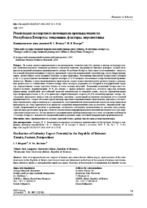Реализация экспортного потенциала промышленности Республики Беларусь: тенденции, факторы, перспективы
Another Title
Realization of Industry Export Potential in the Republic of Belarus: Trends, Factors, Perspectives
Bibliographic entry
Благуш, И. С. Реализация экспортного потенциала промышленности Республики Беларусь: тенденции, факторы, перспективы = Realization of Industry Export Potential in the Republic of Belarus: Trends, Factors, Perspectives / И. С. Благуш, Н. Я. Кажуро // Наука и техника. – 2019. – №1. – С. 75-81.
Abstract
На основе анализа национальных и международных статистических баз данных и метода экспертных оценок выявлены основные тенденции развития и определен комплекс внутренних и внешних факторов, воздействующих на экспортный потенциал промышленного сектора Республики Беларусь. Актуальность исследования – показать, что в малой открытой экономике Беларуси, принявшей в качестве национальной стратегии курс на постиндустриализацию, значительную часть товарного экспорта создает индустрия. Абсолютные показатели белорусского экспорта услуг в 3,4 раза уступают значениям товарного экспорта, 92,4 % которого обеспечивается обрабатывающей промышленностью. Именно в сфере промышленного производства следует искать причины долгосрочного тренда к сокращению физического и стоимостного объемов белорусского экспорта, ухудшения его товарной и географической структур, отрицательного сальдо торгового баланса и счета текущих операций. Основными позициями белорусского товарного экспорта, формирующими 70 % его объема в страны дальнего зарубежья, остаются сырьевые позиции, подверженные воздействию неустойчивой ценовой конъюнктуры на мировом рынке, хотя на горнодобывающие отрасли приходится всего 1,2 %, в то время как в обрабатывающих создается 85,6 % валовой продукции сектора. Исследование опровергает вывод о том, что проблемы, связанные с реализацией экспортного потенциала отечественной промышленности, следует объяснять кризисом индустриального промышленного производства, доказывая, что постиндустриализация, сопровождающаяся сокращением, свертыванием или трансграничным переносом индустриальных производств, не столь однозначна и не приносит ожидаемых макроэкономических результатов. Национальной стратегией, направленной на развитие и реализацию экспортного потенциала промышленности, должны стать реиндустриализация, достижение прорыва в области использования информационных технологий для нового качества индустриального производства, что предполагает переориентацию функционирующего на основе аутсорсинговой модели IT-сектора Беларуси с внешнего на внутренний рынок и решение задач системной модернизации промышленности.
Abstract in another language
Main development trends and complex of internal and external factors influencing on export potential of the industrial sector in the Republic of Belarus have been revealed and determined on the basis of the analysis of national and international statistical databases and method for expert assessment. Relevance of the research is to demonstrate that industry creates a significant part of commodity exports in the small open economy of the Republic of Belarus which has adopted a course to post-industrialization as a national strategy. Absolute figures of the Belarusian export of services are 3.4 times lower than values of the commodity export, 92.4 % of which is provided by manufacturing industry. It is in the sphere of industrial production that we should look for the reasons of long-term trend to reducing physical and cost volumes of Belarusian export, deterioration of its commodity and geographical structure, negative balance of trade and account of current operations. Main positions of the Belarusian commodity exports which form 70 % of its volume to non-CIS countries are raw materials exposed to unstable price environment in the world market, although the mining industry accounts for only 1.2 % while the manufacturing industry creates 85.6 % of the sector’s gross output. The study refutes the conclusion that problems associated with implementation of an export potential of domestic industry should be explained by the crisis of industrial production, proving that post-industrialization, accompanied by a reduction, curtailment or cross-border transfer of industrial production, is not so clear and does not bring the expected macroeconomic results. Reindustrialization, achievement of a breakthrough in the use of information technologies for a new quality of industrial production, which involves reorientation of IT-sector in Belarus operating on the basis of an outsourcing model from external to domestic market and solution of problems concerning system modernization of industry must become a national strategy aimed at the development and implementation of the industry’s export potential.
View/
Collections
- № 1[11]

